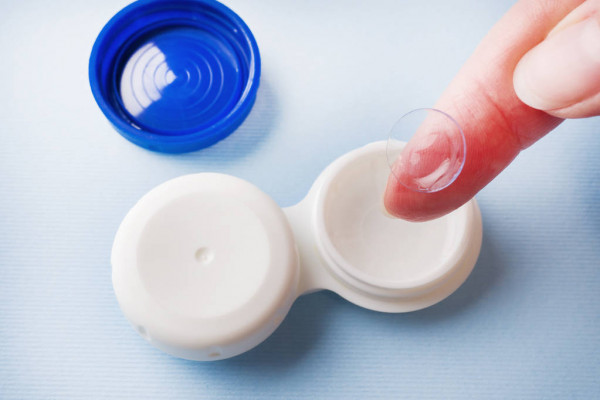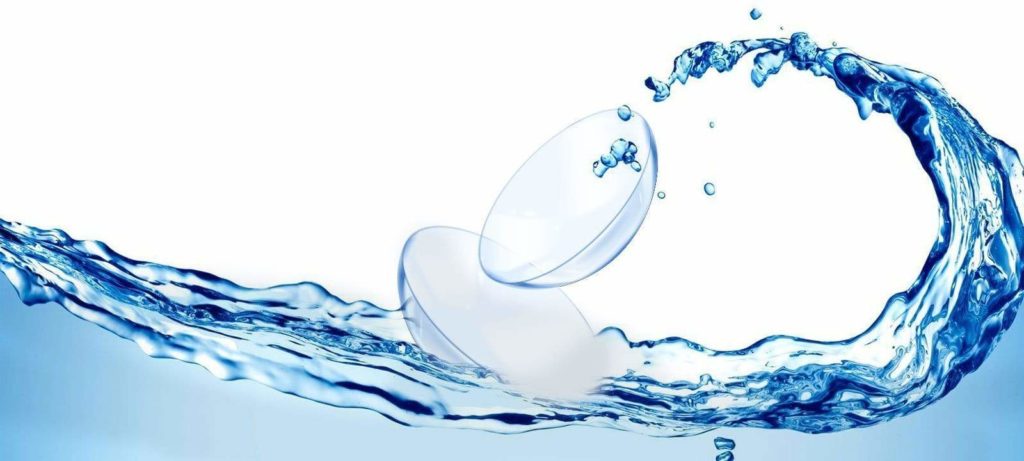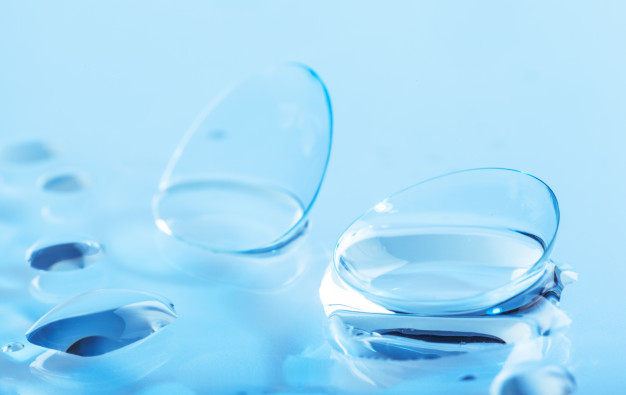Water content is one of the most important parameters when choosing quality contact lens. Moisture retention is another critical factor influenced by the water content of a contact lens. Water content also is an important factor of the various plastics which are used to make soft contact lenses. In the cases of conventional soft contact lenses, higher water content of a contact lenses can let more oxygen pass through the lens to the surface of the eye. So this is important for lens comfort and healthy eyes.
However, high water content can be more fragile, so they are more likely to tear with frequent handling. A lot of contact lenses now contain between 50% and 60% water and some contain over 70%. But we cannot say that a high water content contact is much better that a low one, because in the cases of dry eyes, a low-water-content lens is better, since the low-water content lens holds its shape better in dry environments and fits better, and it is also less dependent on absorbing your tears to maintain its shape.

Understanding Contact Lens Materials
The Importance of Water Content
Water content is a crucial parameter when selecting quality contact lenses. It plays a significant role in the various plastics used to make soft contact lenses. Higher water content in conventional soft contact lenses allows more oxygen to pass through the lens to the eye’s surface, contributing to lens comfort and healthy eyes. However, high water content can also make lenses more fragile and prone to tearing with frequent handling.
Contact lenses typically contain between 50% and 60% water, although some lenses can contain over 70% water. Low-water-content lenses are better suited for individuals with dry eyes, as they hold their shape better in dry environments and are less dependent on absorbing tears to maintain their shape. Therefore, understanding the water content of a contact lens is essential for ensuring both comfort and durability.
How much water do contact lenses contain?
Depending on the water content, contact lenses can be divided into three groups. Each group means a slightly different quality in contact lenses. Do you know which group your contact lenses belong to?
-
High water content (up to 75%) – Contrary to popular belief, lenses with a high water content attract the tears of the eye and thus make them more susceptible to drying out. The higher the water content of a contact lenses, however, the more oxygen reaches the cornea. In addition, contact lenses with a high water content are considered to be easier to handle when inserting, removing, cleaning and disinfecting.
-
Mid water content (up to 60%) – Hydrogel contact lenses with a medium water content are suitable for most lens wearers. They allow oxygen to flow to the cornea without absorbing the water of the natural tear film.
-
Low water content (up to 40%) – Soft contact lenses with a low water content level of about 38% feel comfortable and let your eyes breathe without drying them out.
How can I find out water content in my contact lens?
Basically, you’ll be able to find the water content percentage displayed on the packaging of your contact lenses. The absorption rate of a contact lens indicates how much water the lens can absorb from its surroundings. The percentage of water content that you see in the contact lens product packaging is displaying the percentage size of the lens in absorbing water in the nearby areas. It is not the amount of water contained in the contact lens. In the product packaging, you’ll also spot the components that make up the rest of the lens and the material used to design the surface of the lens.
Oxygen Permeability and Water Content
Oxygen permeability is a critical factor in contact lens design, as it allows for the transmission of oxygen to the eye’s surface. Water content plays a significant role in determining oxygen permeability, as lenses with high water content tend to allow for better oxygen transmission. However, the relationship between water content and oxygen permeability is not always straightforward, and other factors such as lens material and design can also impact oxygen transmission.
Silicone hydrogel lenses, for example, offer high levels of oxygen permeability despite having a lower water content than hydrogel lenses. This is due to the unique properties of silicone, which allows for high levels of oxygen transmission while maintaining a low water content. Therefore, when considering oxygen permeability, it’s essential to look at both the water content and the material of the lens.
Dry Eyes and Water Content
Dry eyes are a common problem for contact lens wearers, and water content can play a significant role in exacerbating or alleviating this issue. Lenses with high water content can sometimes exacerbate dry eyes, as they can draw moisture from the eye’s surface. On the other hand, lenses with low water content may be better suited for individuals with dry eyes, as they are less likely to absorb moisture from the eye’s surface.
However, it’s essential to note that water content is just one factor to consider when it comes to dry eyes. Other factors such as lens material, design, and wear schedule can also impact comfort and dryness. For those with dry eyes, silicone hydrogel lenses are often recommended as they combine the benefits of lower water content with high oxygen permeability, helping to keep eyes hydrated and comfortable throughout the day.
Which water content is the best for you?

High water content lenses are generally not the best for dry eyes. Contact lens wearers who are more prone to dry eye syndrome will find contact lenses with lower water content more comfortable to wear. If you suffer from dry eyes, soft contact lenses with a high water content may be problematic for you, as they absorb the eye’s natural tear film. Therefore advises you to wear silicone hydrogel lenses, which combine the advantages of contacts with a lower water content and superior oxygen permeability.
With high water content lenses, the moisture in the lens draws out the eye’s tears, making them more prone to dehydration. High water contact lenses are also more likely to become dehydrated due to everyday environmental factors such as excessive screen use and air conditioning.
Wearing soft contact lenses can dry your eyes out due to modern-day living. This is known as contact lens induced dry eyes (CLIDE) and is slightly different to dry eyes syndrome. It occurs because the thin layer of contact lens material on your cornea limits oxygen flow to the eyes. Without a steady flow of oxygen, your eyes struggle to develop natural tears.
Silicone hydrogel contact lenses are a popular choice for those with more sensitive eyes as they allow more oxygen to pass through the material than standard hydrogel material. They also have a higher oxygen transmission which means that eyes will stay fresh and healthy throughout the day. The material keeps your eyes hydrated so that they don’t get dry as easily.
Some people refer to the oxygen permeability of contact lenses as the DK/t value. The unit of measurement for oxygen permeability through a contact lens depends on the thickness of the lens. Gas permeable contact lenses are usually classified according to their DK/t value. These lenses do not contain high-water content.
Your optometrist will prescribe you the best lenses for your eyes, and if you have particularly dry eyes, then you’ll most likely be prescribed mid-water type lenses due to their versatility and comfort. Let’s book an appointment with us at Malaya Optical Optometrist to know what are the best lenses for your eye.


